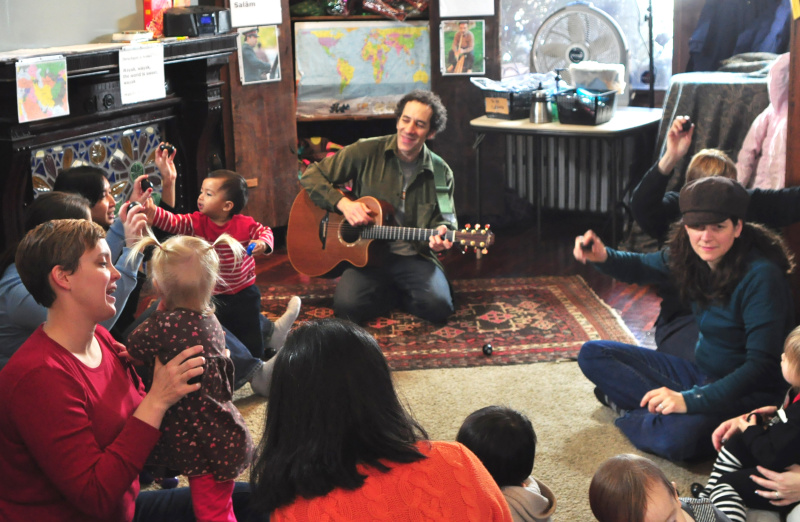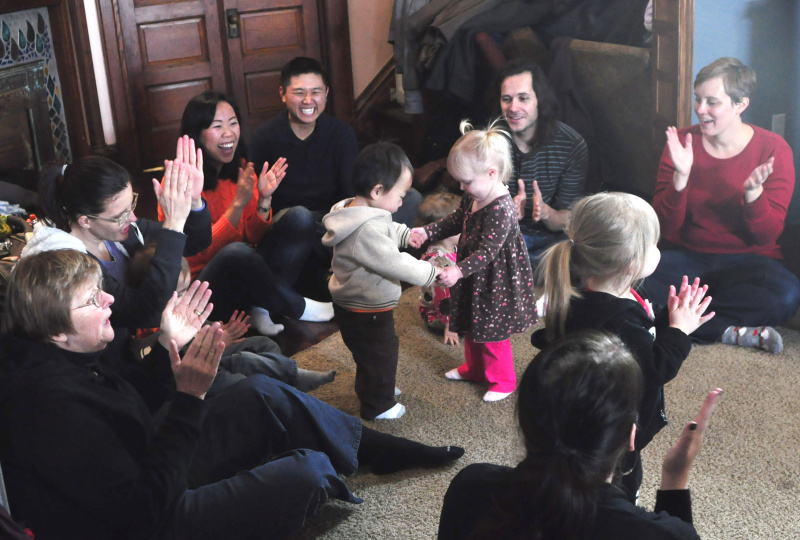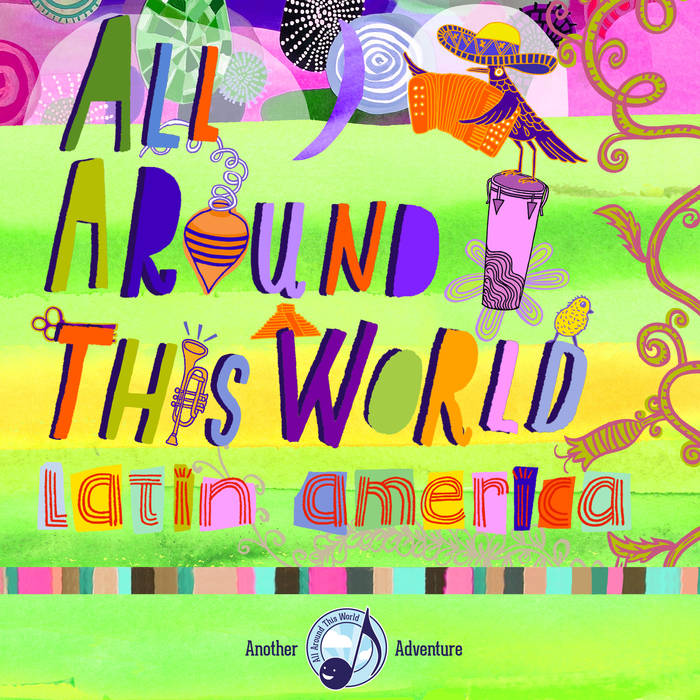
All Around This World
by Jay Sand
An Explorer With a Guitar
My personal road to teaching music to kids in my Philadelphia living room runs through Europe, Asia, and Africa. I’ve always been an explorer, always peering just over the horizon for the next thing to learn, and I always had a guitar in hand while doing it. When I was a junior in college I cut out for a semester and spent three months traveling in Europe on an unlimited Eurail pass, sleeping on trains wedged between other grubby backpackers. In that multilingual world, the guitar was better than a handshake. On train platforms, street corners, in questionable hostel cafes, travelers from everywhere would sing in full voice to what they called “American music”—the Beatles, the Stones, Bob Marley. After college I ventured to Southeast Asia, landing in Vietnam where I sang pop songs with ex-pats and jammed with Vietnamese metalheads. Later I journeyed to Africa to learn about the histories and cultures of communities that practice Judaism, bringing songs from Jewish Ghanaian shopkeepers, Jewish Ugandan farmers, and Jewish Zimbabwean railway clerks home to share with American Jews—who, by singing these songs, found a simple way to accept that such complicated communities exist.
I found through my travels
that music was magic, the most basic way to connect. A song bulldozed boundaries. A song opened hearts.
I found through my travels that music was magic, the most basic way to connect. A song bulldozed boundaries. A song opened hearts.
I’d never considered playing music with little kids until I got a boost from the Buddha. My brother’s friend was teaching at Sally’s Music Circle, a parent-child music program based in the Philly suburbs, when he answered the call to become a Buddhist monk. He left for the monastery and asked my brother to fill his spot. When Buddha kept calling, my brother kept teaching.
When my first daughter was a baby, I brought her to class at Sally’s. My daughter giggled, I gushed. Music filled every one of us in the room. We sang full-bodied songs.
I knew music could blast borders between backpackers, but had never considered that singing would give me the chance to speak the same language as my child. The pathway had opened—now we could talk! I was hypnotized. I was hooked.

I soon became a Sally’s Music Circle teacher and taught a class a week, then two, then more. As I trained, I marveled at the work visionary educators like Kodály, Orff, Suzuki, and Edwin Gordon have done for a hundred years to enhance and value the music already present in children’s lives. I dove into research by neuroscientists, psychologists, and all stripes of educators showing how music feeds a child’s brain.
At home I was talking more and more to my daughter in songs. I was so eager to tell her about my adventures and all the ways I met the world. We began to play a game with a global map. She, in her then–three-year-old–ness, would point to a country. We’d take to YouTube, find songs from that place, and sing along. I took her on journeys each day. She was too young to understand, but she understood.
We were having too much fun, and learning too much, to keep our journeys to ourselves. I decided to fuse my teaching with my travels, sharing these musical explorations with other children in the neighborhood, by creating a program I called All Around This World.
Singing Songs From Everywhere
My program is an interactive project for infants through nine-year-olds and their grown-ups to musically journey around the globe, singing, moving, and exploring different countries and cultures.

I knew building a complete world music curriculum for kids would be an honor, a challenge, and a chore. My goal was to craft an encompassing and inspiring resource: sourcing, translating, adapting, and thoroughly kid-testing family-friendly music from every inhabited continent. The process took four full years, and more. Even today I test and tinker. I’m always seeking another song.
With the world map as my guide, I divided the globe into ten general regions and constructed a three-month curriculum based on each: Latin America first, then Africa, South and Central Asia, and the Caribbean. After that, Eastern Europe, East and Southeast Asia, West Asia and the Middle East, Oceania and the Pacific, Western Europe and the Nordic countries, and last but not nearly least, the United States and Canada. To complete a three-year journey, I also created two cross-border units—“Everything Is a Drum,” which celebrates the world’s rhythms, and “Connecting the Dots,” which solves mysteries that have musical themes.
Each time I set out to create a new season, I dispensed with whatever I thought I knew about a region’s music and committed to starting from scratch. My mission was to keep my mind open as I listened to thousands of songs. I’d dive deep into research about the music traditions of a specific place, mapping the countries, cultures, and musical memes. I’d search for songs from the genres that told the countries’ best tales. At first I thought I’d focus mainly on children’s music, but I soon realized any song ever written could potentially be just right. YouTube enabled my listening tour, as did the mind-blowing resources of Smithsonian Folkways recordings, the Lomax tapes, David Fanshawe’s Polynesian collections, Francis Corpataux’s series of international children’s songs, and of course the marvelous website, Mama Lisa’s World.
Even with almost unlimited sources, I still had to struggle to find the right songs. There’s no fixed formula for an All Around This World song, but I know one when I hear one. The tune has to be a ray of light, with a chorus or “hook” kids can catch, but also a song that has roots in a people or place, a composition that resonates deeply. It may tell a story that’s important in a country or have a melody a whole culture sings. It may be well known, a narrative everyone shares, or it could be the work of a contemporary writer who has channeled a homeland’s heart. Beyond all that, it has to work. Each song in my class has an attached kinesthetic motion—patting, clapping, rocking, rowing, drumming, shaking eggs or clicking sticks, dancing in circles around the room. Each has to be fun and formidable, straightforward enough for the littlest kids to immediately sing along, yet with enough depth to make grown-ups think.
My goal for each song was to capture its essence, to maintain its musical soul
I’d make lists of hundreds of songs, then listen, listen, listen until I’d find about fifty songs that instinct told me would immediately connect with my little students—songs with a strong chorus, an intriguing narrative, an interesting time signature. From there I’d dig for translations—finding some on the Internet, some from multilingual friends, or, when necessary, actually hiring translators—then learn the music by ear, play along, and adapt. My goal for each song was to capture its essence, to maintain its musical soul, keeping the melody intact but mixing the original language with English so everyone would know what they sang.
My final list for each season consists of twenty-five to thirty songs that come as close as I can muster to telling that region’s tale. Each song plays a specific role in its region, mapping every kind of diversity—geographic, historical, cultural, linguistic, religious, and more. The list also is musically satisfying—including meaningful melodies and challenging time signatures, songs of many tempi and moods—and encourages movement of all types, from spin-around-the-room songs to sit and sway lullabies. (I’ll always be grateful to Dr. Sally Weaver of Sally’s Music Circle for giving every best kind of advice on building my repertoire.)
Atas Atas (Algeria)
For example, in the West Asia and Middle East season, there are songs from all over the region— Turkey to Iraq, Azerbaijan to Yemen, Saudi Arabia to Iran. There is music from both Israeli and Palestinian artists, songs from Turkish, Syrian, and Iraqi Kurds. We sing an Egyptian song about Bedouins traveling through the desert to find water, an Armenian song about a rollicking party, a Palestinian song about seeking the stars. There is an Azeri lullaby, a Kurdish lament about love, an Israeli plea for peace.
Beyond the Songs
Each week we learn something new. We “visit” a country and feature a special experience from that place—a Georgian supra (feast), an Iraqi belly dance, an introduction to the Hajj, or Muslim pilgrimage. Songs used to support our explorations, however, make multiple appearances over the course of a season, so that by the end, everyone can sing along. Families also have a CD that they can sing along with at home.

The musical structure I bake deeply into the curriculum is a structure I learned at Sally’s Music Circle. Over three decades of teaching, Sally built upon a foundation of deep research into the way children learn. Classes start with our hello song, “We Are Happy,” a greeting song from Uganda, paired with a salutation from the featured country of the week. We begin sitting down and sing songs that are hand plays or lap bounces; we clap, we pat, we rock and row. After warming up our bodies and our voices, it’s time to move! During our next song, we stand, dance a bit, fly, and swim. We stomp and jump around the room. After that I hand out instruments—shaker eggs, sticks, drums, tambourines—and sing a song that lets kids shake or drum or click. At this point, about a half hour along, the kiddos need a break, a chance to stop looking at me and play for a moment with parents or caregivers. So there might be unstructured time with scarves, a moment to master peekaboo. After scarves we lullaby or hand play, rouse ourselves for the week’s “experience,” then end with a triumphant free play—an abundance of percussion instruments strewn on the floor, or a bucket of pots and pans from the kitchen, or—most kids’ favorite—a big bag of bouncy balls. We wind up with a reprise of “We Are Happy,” and end with triumphant high fives.
If you’re a teacher, you know that prep work is key. No matter what you teach, the deeper the foundation built by research, craft, and design, the better you know what you’re going to share, and the more confidence you bring to your class. The point of all that preparation is not to wow the class with your knowledge, but to free yourself to be real.
The beauty of being with little kids is that wherever they are, they are there. A toddler who’s dancing is in full-body dance; when she smiles it’s a full-body smile. There’s no split attention, no worry or woe…no future to fret, and no past. The kids are there, and when I’m able, I’m right there too. These are the moments when everything works. The music envelops the kids in the room; through it, together, we “speak.” As we talk musically, the languages and rhythms and cultures sink deep.
Or at least that’s what I believe. Teachers of the tiniest kids know the feedback is fast—when kids are happy, sunshine abounds. But in the long term, we can only have faith that the seeds we plant will bear fruit. We’ll never know our impact, our role in their road, whether we’ve helped form their path. We dance and we sing and bring joy when we can. Beyond that, we only have hope.
What We Teach Our Children About the World Matters
In the years since I started All Around This World, I’ve taught over a thousand classes to kids and their families. I’ve traveled around the country playing concerts and presented music in libraries, community centers, and homeschoolers’ living rooms. I’ve developed online classes and interactive lesson plans for teachers who want to teach kids global songs. Every time I teach I have the honor of seeing grown-ups do right by their children. Caring, insightful, bold parents abound. I sing with them every day.
I believe that introducing kids to the extraordinary riches of culture, traditions, and thoughts those far-off people offer is the true ‘wealth of nations’
And yet every day, our wide, wonderful world gets smaller. Parents know their kids are connected to everything all the time—born with an iPhone and an Internet chip. Our children are blessed to be the first of all time to grow up with access to all humanity’s accumulated knowledge in the palm of the hand. They will also experience fewer and fewer barriers to connecting with people who live in other parts of the globe. I believe that introducing kids to the extraordinary riches of culture, traditions, and thoughts those far-off people offer is the true “wealth of nations” that will prepare them for what will be an unavoidably international and interdependent future.
At the same time, such openness is scary, and some fight it for all they are worth. The future, the unknown, appears as a threat. The world turns beyond our control. Hatred and fear are simple to feel when we limit our perspective, our access to the world. Teaching kids tolerance from their very first days will ground them in peace and help them navigate the challenges that await.
We may “just” be teachers of the tiniest kids, not always granted respect, but many of us have a mission. We don’t just show up in the classroom each day to help kids pass the time. We talk with kids through music, teach kindness, and seed hope. In All Around This World classes I sing and dance and play, and share my travels with kids to help build a better world.
The stakes are too high for us not to do this work. Everything depends on it.